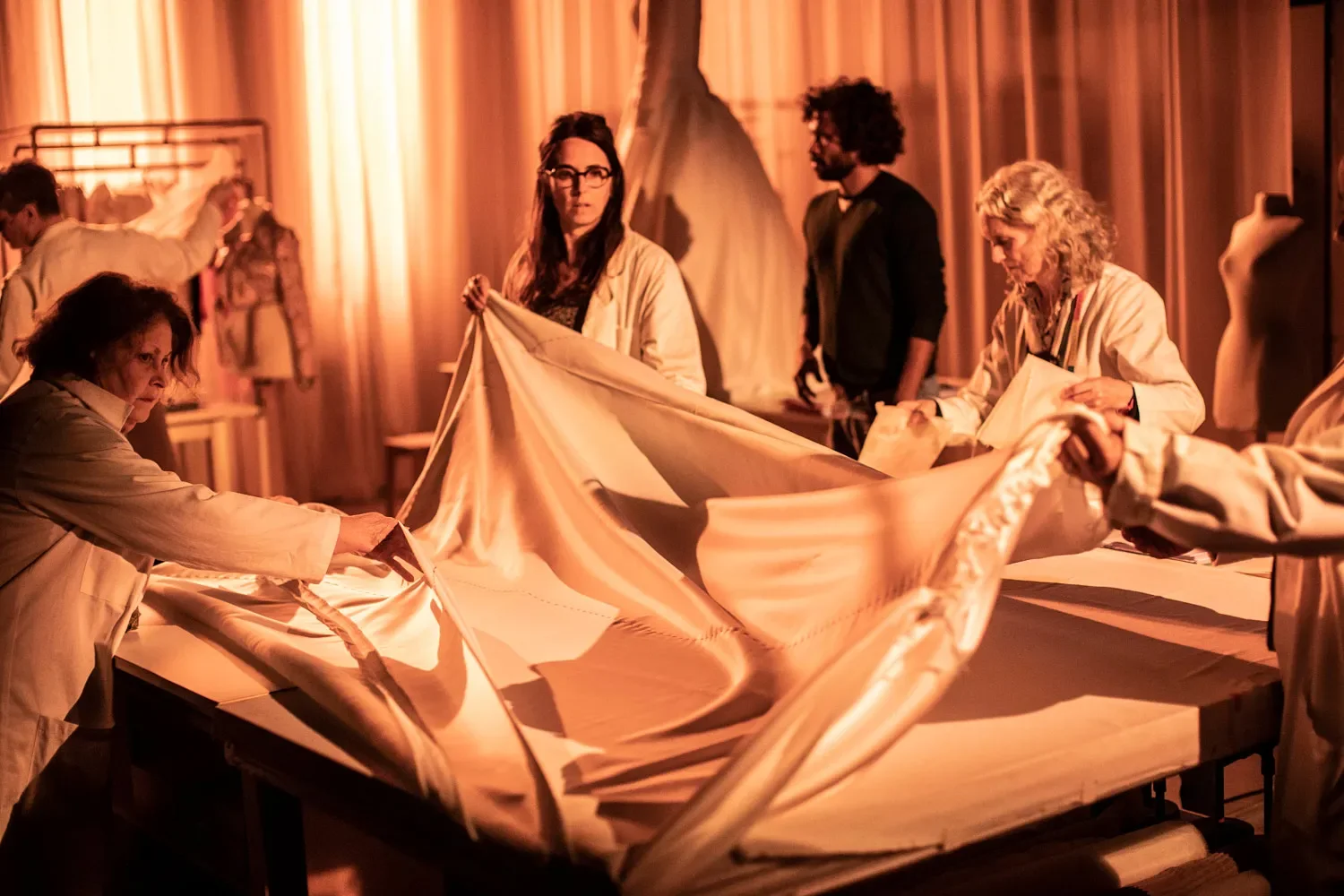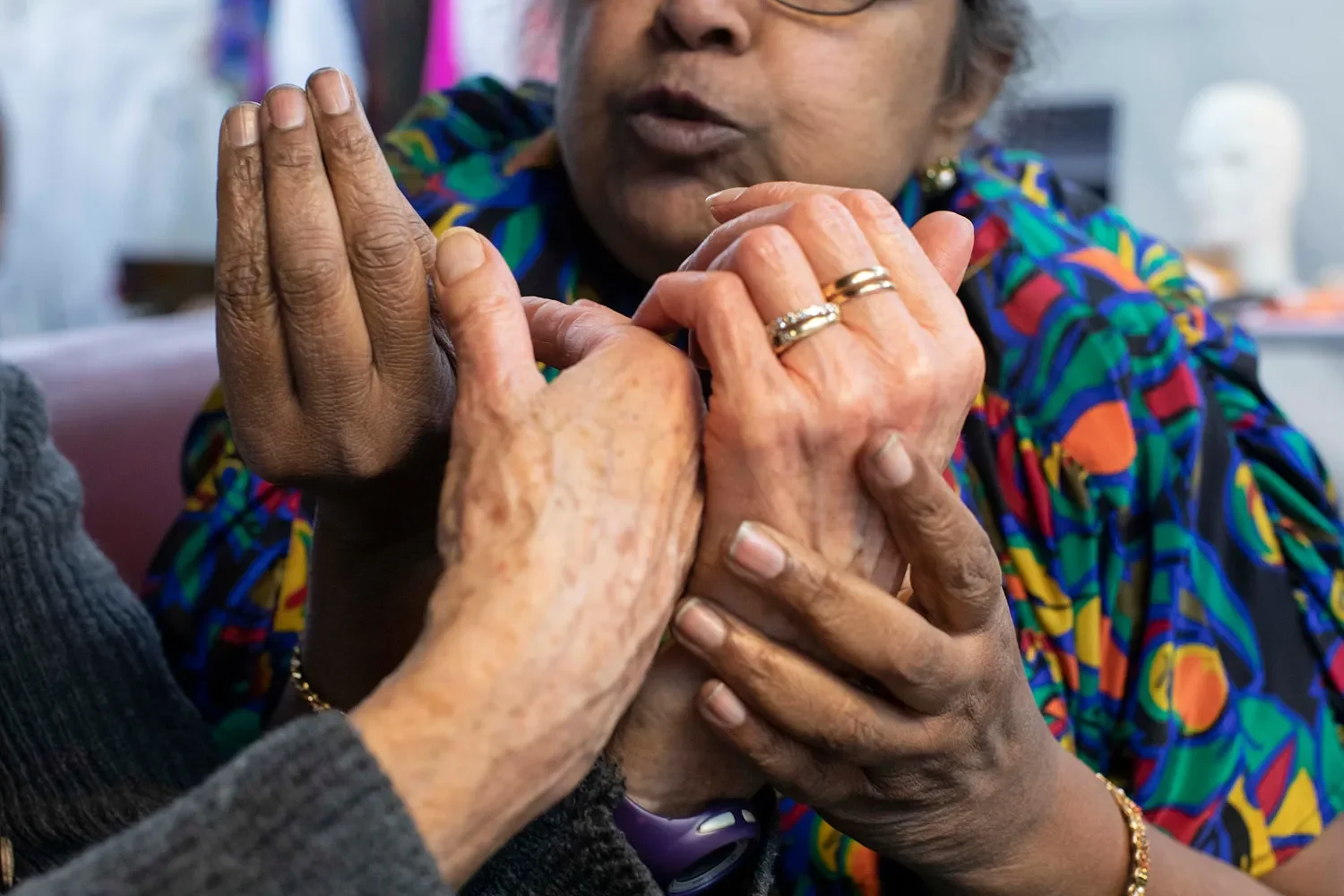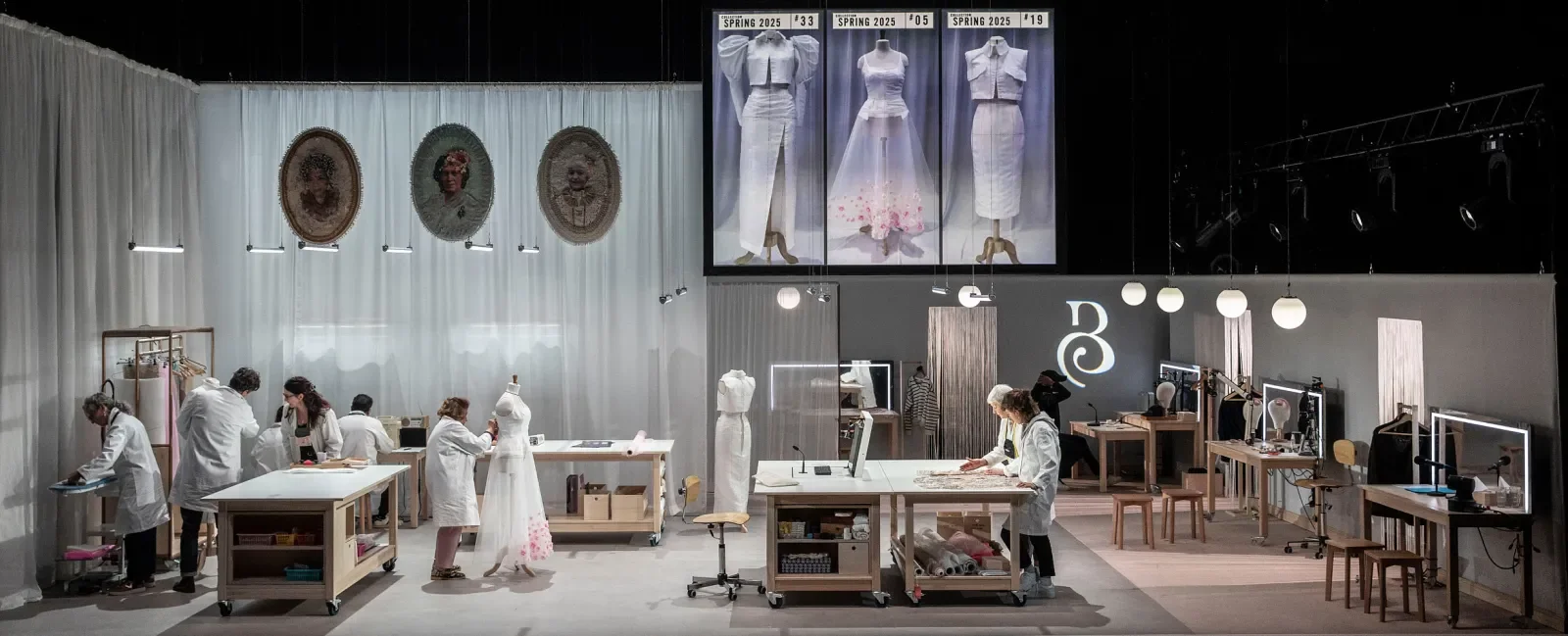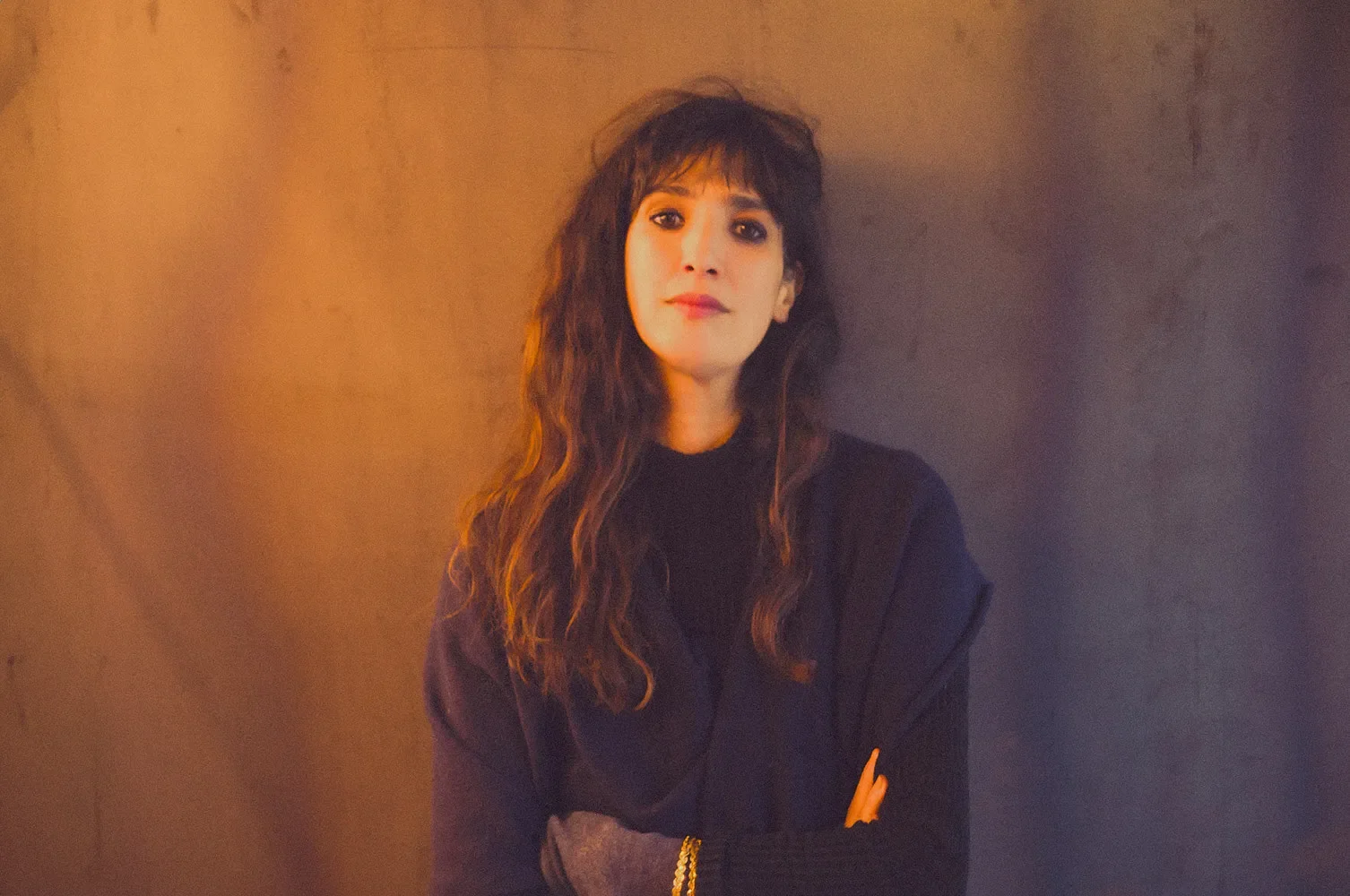The Weight of Beauty: LACRIMA at The Barbican
Photos by Jean-Louis Fernandez
Edited by Valeria Berghinz
What labour lies beneath ceremony? Whose hands shape what power wears? From the delicate threading of pearls to intricate embroidery, LACRIMA traces the hidden hands behind the creation of a single wedding dress for British royalty. In this captivating new work, acclaimed playwright and director Caroline Guiela Nguyen transforms the dress into a vessel for stories of artistry, devotion, and systemic injustice.
The stage itself becomes a chorus of perspectives: alive with multiple screens in a zoom-conference style, interwoven with close-ups of hands in the act of creation, fragments of cloth, pearls and thread. While the workers’ faces are lit and fragile in their humanity, the voices of those who hold power remain faceless – disembodied, unreachable, demanding. Their authority is felt everywhere, but never embodied; cries out for understanding and redress are never met with a human face.
Spanning ateliers in Paris, Alençon, and Mumbai, the production unfolds in a multilingual, multimedia tapestry. What emerges is a narrative of inequality and resilience, a reckoning with the neocolonial system embedded in fashion today, and an invitation for audiences to sit with stories that have too often gone unseen.
The Cold Magazine [CM]: LACRIMA reveals the hidden labour behind a single wedding dress. What possibilities does this object open up for you as a dramaturgical device and what tensions arise in using a symbol of luxury and spectacle to reveal hidden structures of labor and inequality?
Caroline Guiela Nguyen [CGN]: LACRIMA moves through the workshop… to the fire. In fact, the question of the dress allows me to create a very concrete narrative element that lets me travel from one space to another. In my writing, I am always drawn to the question of the chorus, of multiple viewpoints, and in that sense, all the shows I’ve created have always had a choral element.
In SAIGON, for example, there was the restaurant, this place of passage that allowed me to tell the story of French colonisation in Vietnam. The same with Kindheitsarchive, a show I created in Germany at the Schaubühne in Berlin: there too, the place allowed multiple stories to coexist.
[CGN]: Here, the dress plays that role: it brings together all the hands that are working on it. And very quickly – almost like in a tale – I understood that it would be a very powerful dramatic element. When I wrote the first lines in my notebook, I actually drafted the pitch for LACRIMA like the beginning of a tale: ‘Once upon a time there was a dress, and all the hands touching it would, in some way, be cursed.’
It’s a dramatic device that allows me to travel between these three places – even four, in fact, with England (where the dress was commissioned, and its destination). As for the tensions that arise when using a symbol of luxury and spectacle to reveal hidden structures of labour, they are very concrete. I know the pressures surrounding professions linked to performances, because I myself make theatre. I clearly see what is visible and what is invisible, I see the resources, the rising pressure as the moment of the performance approaches. I see the stakes, the rushes, the moments of tension. All that seemed perfect to tell my story.
[CM]: In your theatre, private stories often intersect with larger political and historical forces. In LACRIMA, the dress seems almost like an archive of knowledge, histories, and inequalities. Do you find objects carry this narrative weight in your work?
[CGN]: I really like the idea that the dress becomes an archive of knowledge. I find this expression very beautiful. I have always had a strong attraction to objects. For example, in SAIGON, it was very important for me to go behind the scenes at real Vietnamese restaurants in order to reproduce on stage, almost from a sociological point of view, what would exist in reality. It reflects both my taste for the real and my taste for belief.
It was just as important to bring in bowls from my childhood, the kind of bowls you still find in some Vietnamese restaurants, plastic ones decorated with flowers. Of course, they are not porcelain: that says something sociologically. My spaces are always very socially and culturally situated.
In LACRIMA, the dress pushes this principle to its extreme. The whole purpose of the show is to tell the story of the hours and hours of work, condensed into one garment. At the end of the day, it’s still just an object, a dress, however beautiful it may be, but behind it, you can sense all the people who contribute to that beauty. In fact, that’s what the show itself says: these people ‘contribute to the beauty of the World’.
And yet, why is it that we see a dress as so visible? Of course, I think of Lady Di’s dress, of Kate Middleton’s, but also of the dresses on the red carpet at the Cannes Film Festival, at London Fashion Week. When I was writing, it was precisely during Cannes: I saw these dresses everywhere on social media, becoming hyper-visible, while those who, behind every bead, every stitch, had worked to create that beauty, remained completely invisible. That’s what I wanted to tell.
[CM]: Secrets, from domestic abuse to occluded labour, drive much of Lacrima. Are there elements of theatre that allow you to make hidden experiences visible in ways that other forms, like journalism or film, cannot?
[CGN]: I don’t think journalism or cinema cannot offer that. In fact, it was thanks to the New York Times that I learned there were embroiderers in India, and that they were the ones who most often contributed to embroidery work for European haute couture houses. For example, one of my favourite films is Mike Leigh’s ‘Secrets and Lies’. So no, I think journalism and cinema can completely engage with issues around secrecy.
Perhaps, however, it manifests differently. In LACRIMA, for example, there is a part I really love: just before the little intermission offered to the audience, a character, an embroiderer, threads the pearls onto the dress one by one. All of a sudden, it’s as if the performance stops, the story pauses, and we enter the real time that each pearl requires.
That time, where nothing happens except a man, in front of us, taking the time to place one pearl after another, maybe that’s what theatre can offer, and what neither cinema nor journalism can. Because theatre is presence: that time with that real man in front of us – even if he is not truly an embroiderer but an actor embodying this embroiderer – enables us to measure time, to contain it, and to give it true depth.
[CM]: The production is multilingual, including Tamil, French, French Sign Language, and English. Beyond inclusivity, what structural or aesthetic possibilities does multilingualism open up for you?
[CGN]: It’s a very interesting question. Of course, multilingualism creates inclusivity, but it goes far beyond that. I don’t ‘include’ people in my shows: thanks to the actors and actresses, I reflect on linguistic, but also cultural, existential, and spiritual realities. I encounter them through writing, and my writing takes on the landscape that each person carries within them.
Inclusivity would suggest a circle into which we bring people. For me, there is no circle until the people are there: it is the people present who create the circle, who create the landscape. Concretely, when you hear Vietnamese or Tamil in the room, I see spectators often from these communities – suddenly feeling involved. I am very happy because people who are usually less present in theatre are there. On stage as in the auditorium, it is those people who make the show and who make the audience.
[CM]: Your stagecraft blends hyper-realism with artifice, from workshop sets to split-screen video projections. How do you navigate between documentary precision and poetic invention?
[CGN]: There isn’t, on one side, what belongs to reality, and on the other, poetry. When I discovered, for example, the reality of lacemakers – who have to work in near silence to focus on their stitches – it was absolutely real and poetic. So, I don’t separate the two. I write with a constant concern for poetry – I am a writer, and that is undoubtedly the most important thing for me – but all my lifeblood comes from the way I look at reality. I don’t navigate from one to the other: I feel made entirely of both.
[CM]: Critics have described your dramaturgy as “choral,” with multiple voices and perspectives intertwined. How do you think this multiplicity contributes to the rhythm, tension, or narrative clarity of your productions?
[CGN]: Yes, I mentioned the choral element above. I have always written that way, but not because it automatically creates tension or because it’s simply a dramaturgical tool. It’s deeper than that: the question that always runs through me is “what do we have in common?” What do a woman making lace in Alençon and a man embroidering in Mumbai have in common? Does something exist between us that is common? Choral dramaturgy is precisely what allows me to respond to that.
[CM]: You’ve described yourself as the daughter of immigrants, with roots in Vietnam, North Africa, and Provence. How has this shaped your resistance to single-perspective storytelling?
[CGN]: I’ll answer simply: for me, a story based on a single perspective is not a story. A newspaper article can be a point of view; a story cannot. That’s why the characters in my plays are always surrounded by a 360-degree gaze. I don’t make theatre ‘the way I do’ because my father was a Jewish pied-noir born in Algeria, my mother is Vietnamese and Indian, and I grew up in Provence; I make theatre to respond to those very questions. I would be incapable of writing something that only includes one perspective.
[CM]: As Lacrima makes its UK debut at the Barbican, what do you hope British audiences will take from it?
[CGN]: It is an honour to perform for the first time in the UK, and a privilege to be invited to the Barbican; we are very happy about it. I would like the audiences in London to take away what I myself wanted to hold onto when writing the play: the embroiderers we do not see, the lacemakers we do not know, the ‘little hands’ who make the dress. I would like us to remember what Abdoul’s daughter repeats to her father: “Lift your head, papa, and don’t forget that you contribute to the beauty of the world.” What I want people to take away are these people who contribute to the beauty of the world.
UK premiere at the Barbican Theatre, Thu 25 – Sat 27 Sep 2025.
Images 01-05: LACRIMA directed by Caroline Guiela Nguyen.
Photographer credit: Jean-Louis Fernandez



